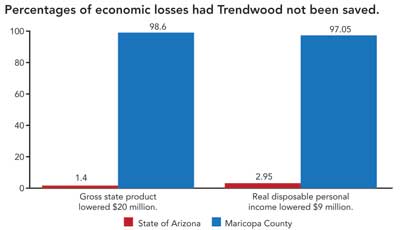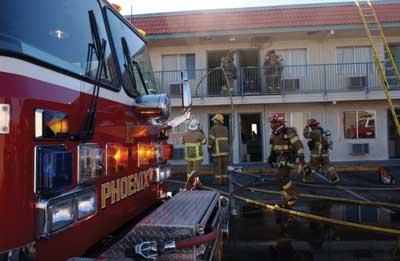BY TIMOTHY KREIS
What is the real economic impact of firefighting operations on the communities you serve, and how do you measure it? Employing a career fire department with aggressive firefighting tactics intuitively provides an effective means to protect lives and property. Moreover, the Phoenix (AZ) Fire Department (PFD) and the American fire service have methods of evaluating efficacy in the following dimensions: response times, deployment, and fire loss among others. But these dimensions don’t say anything concrete about economics. To better understand the economics, the PFD, the United Phoenix Firefighters Association (L493), and economic scientists currently study these questions. The answers will change the way our nation looks at firefighters and the service we provide.
The origin of this endeavor was a fast-moving fire at a Trendwood manufacturing facility located in central Phoenix. This fire started in a dry river bottom and quickly extended onto the property. With quick response, well-prepared fire companies, and hours of firefighting, crews extinguished the fire. After this incident, we began to discuss the value of the career firefighting efforts that had unfolded.
Clearly, the structure was saved, business operations would continue, and employees would be able to go back to work the next day. The business would continue buying, building, and selling goods; and the people who worked there would stay employed. But what would the results have been if the building were lost? Suddenly, we had fallen on a powerful thought-changing a culture of “fire loss” to a culture of “fire save.”
To answer some of our questions, we contacted Arizona State University’s W.P. Carey School of Business-Seidman Research Institute (SRI), a well-known and nationally recognized business school. In our initial conversations, we learned that our questions were economic and the answers were scientific. Our new friends at the university agreed to study the economic impact of our firefighting efforts at the incident. The results of this pilot study were staggering and prompted further investigation of the economic impact of the PFD within our community.
![(1) Defensive fire incidents or incidents that caused major damages to businesses were not included in the study. [Photos courtesy of the Phoenix (AZ) Fire Department.]](https://emberly.fireengineering.com/wp-content/uploads/2013/08/kreis1a-1308fe.jpg) |
| (1) Defensive fire incidents or incidents that caused major damages to businesses were not included in the study. [Photos courtesy of the Phoenix (AZ) Fire Department.] |
The pilot study revealed that the PFD completely saved the manufacturing facility and that, if the save had not occurred, the facility’s production capability would have been lost for up to one year. Had this building been destroyed by fire, the company would no longer be buying, building, and selling goods. The SRI stated, “Up to 203 jobs would have been lost if the PFD had not saved this manufacturing facility” (Figure 1). “Real gross state product would be lowered by approximately $20 million and real disposable personal income by approximately $9 million. More than 97 percent of these negative economic impacts would have taken place in Maricopa County had this building not been saved” (Figure 2). These potential employment and economic losses were calculated using standardized and scientifically proven methodology.
| Figure 1. Jobs Lost Without Save |
 |
| Figure 2. Percentages of Economic Losses |
 |
STUDY UNDERWAY
Currently, the PFD is participating in a comprehensive study of the economic impact of firefighting on all fire incidents deemed eligible as saves. Underwriters Laboratories and SRI have partnered to conduct this study. Their work will provide a cumulative and conservative assessment of the economic impact of the PFD for one year.
The PFD has many methods of assessing its effectiveness as an organization. The purpose of this study is to assess the PFD’s fire suppression efforts as they relate to local economic continuity. The primary goal was to develop a validated fire incident economic assessment methodology. With this information, the PFD will be able to evaluate its operational effectiveness directly from an economic perspective.
 |
| (2) The Phoenix Fire Department extinguishes many fires before major damages are done to the structure. These fire incidents represent a major portion of the department’s call activity and prevent interruptions in the local economy. |
The study essentially requires two types of evaluation. The first evaluation is fire-save eligibility. All PFD firefighters receive training on this program, which includes how to recognize a fire-save, which is basically defined as any interior fire beyond the incipient phase and outside fires that would surely extend into a structure without quick fire department intervention. Firefighters were trained to TAG incidents that met the study’s eligibility criteria with the dispatch center. The inspector then further investigates these TAGGED incidents to verify their eligibility. Once an incident is deemed eligible and is investigated, the economic impact analysis begins.
The data collected are sent to SRI, which uses an Arizona-specific version of the Regional Economic Modeling Institute (REMI) forecasting model to perform the analysis. This model is a national standard for economic modeling and is used for projects commissioned by the state of Arizona. REMI contains a wealth of details about industries and interindustry relationships. Through this comprehensive modeling program, the SRI can track the economic impact on business at different moments in time and, therefore, determine the economic impact of saving a business from fire.
FIRST QUARTER ASSESSMENT
The assessment for the first quarter has been completed. It includes eight fire incidents from June 1 to August 31, 2012. These fires threatened 13 businesses. The following is what SRI concluded:
- Approximately 2,173 private jobs could have been lost in Arizona over the course of one year if the PFD had not successfully intervened at these fires.
- If government and farm sector employment are included, the total impact could increase to 2,322 jobs for that time period.
- Maricopa County, as the host county, could suffer most of the estimated job losses, including 495 full‐time direct jobs for at least one year.
- Gross state product could have been lowered by approximately $196 million (2012 dollars) throughout Arizona and real disposable personal income by $94.6 million (2012 dollars).
- State revenues could have fallen by approximately $10.6 million (2012 dollars) throughout the state.
- The PFD is, therefore, estimated to exert a significant impact on the local economy at both the state and county levels.
Another way to look at this is as follows: The Bureau of Labor Statistics reported Arizona’s unemployment for the first quarter at 8.1 percent. Had we not saved those businesses, it would have been 8.4 percent. In addition, Arizona could have lost $10.6 million in annual taxes through the temporary or permanent closure of 13 businesses.
This type of evaluation has many benefits for the fire service. Evaluating the economic impact of firefighting provides a means for assessing fire company deployment from an economic perspective. With this information, we can review the value of adding fire companies to areas that are economically significant. In addition, economic assessment will provide insight with regard to fire suppression tactics on fire incidents where the major goal is saving property. Economic assessment will determine the economic vulnerability of Phoenix by analyzing “losses vs. saves” and how sustainability of emergency services during economic crises is vital to preventing an escalating local recession.
It will take decades to fully understand the impact of firefighters risking their lives to save people and property. Firefighters, company officers, and chief officers need to take a close look at how career firefighting can impact their community. Remember, firefighting is not just well-involved structure fires on the razor’s edge of going defensive. Our wins as firefighters, small and large, count for a lot. We are really good at measuring losses, but how can we better understand our saves? The PFD started with the economic impact of fire saves, which we believe is a worthy endeavor. We have not even begun to understand our true role as firefighters. Now is a good time to begin. More information will be available as the study unfolds.
● TIMOTHY KREIS has been a member of the Phoenix (AZ) Fire Department since 2002. He is a captain on an engine company and previously was an inspector in the Fire Prevention Bureau. He is an adjunct instructor and an advisory board member of the fire science programs of Phoenix College and Paradise Valley Community College. He has been a member of the International Fire Service Training Association for five years.
Fire Engineering Archives

